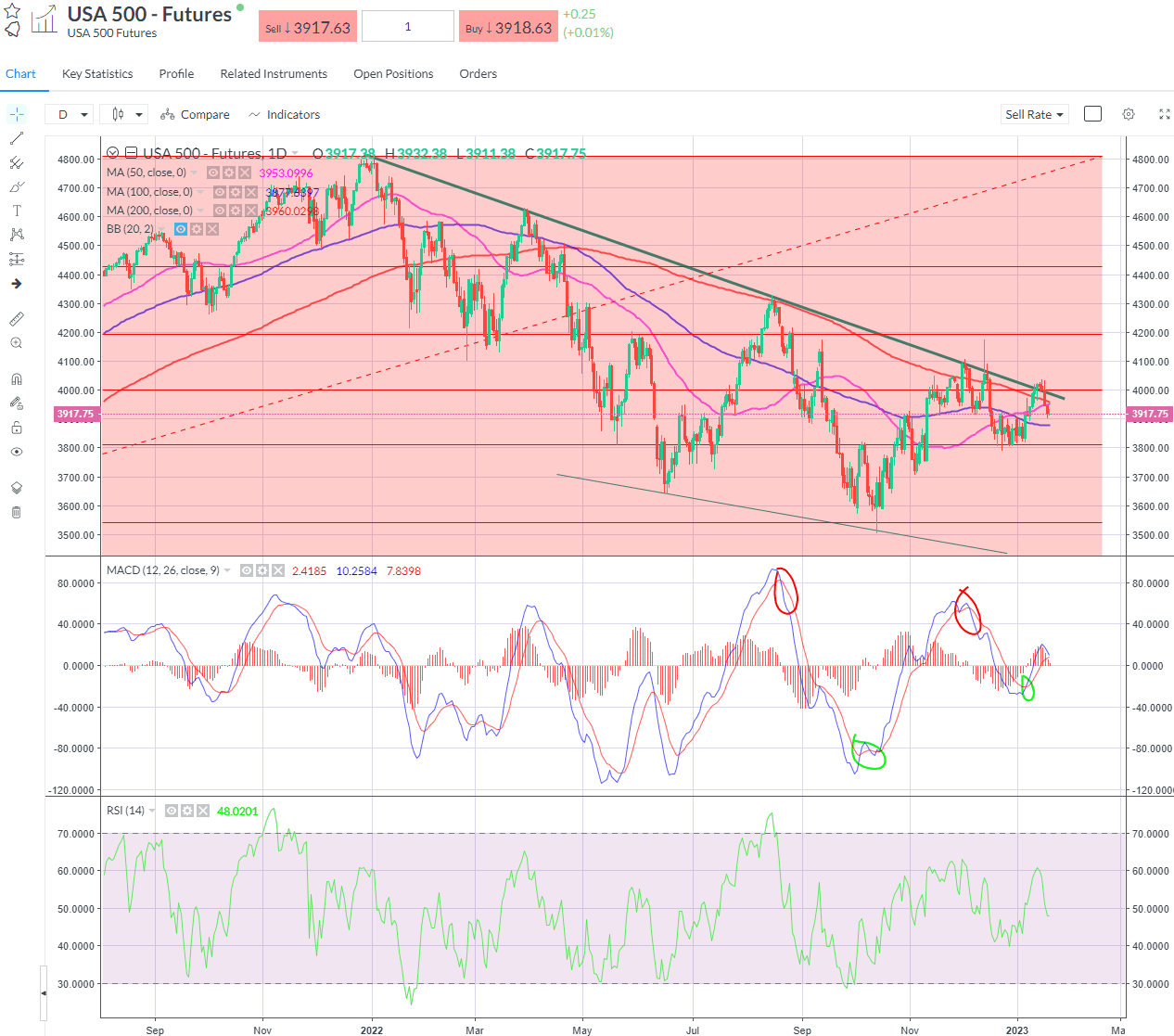
Friday Jan 20 2023 15:47

12 min
Mercifully, it’s the start of the Fed’s blackout period ahead of the FOMC meeting on January 31st-Feb 1st. But there is no shortage of economic data, starting with the latest round of purchasing managers’ surveys. Wrangling over the debt ceiling in Washington may attract some headlines but shouldn’t matter all that much to traders. Risks will be more acute if the situation is not resolved by June, but for now USD and indices should not suffer as a direct consequence of the impasse. Earnings season hits full stride with a quarter of the S&P 500 by market capitalisation reporting, whilst a large number of Dow components are in action.
PMIs
Flash manufacturing and services PMIs for January covering the Euro area, Japan, UK and US are in focus Tuesday. To recap, the downturn in German business activity eased in December as price pressures continue to cool. The composite index rose to 48.9, a six-month high, though still in contraction territory. Businesses were still pessimistic about the year-ahead outlook for activity, but less so than in November. Input cost inflation fell for the third month in a row to its lowest since March 2021, led by a slowdown in manufacturing purchase prices. Overall, the Eurozone composite PMI improved from 47.8 to 48.8 in December and input cost inflation rose at the slowest pace since May 2021.
But the euro area was a rare bright spot in December – global survey data showed the pace of economic growth weakening across the developed markets in one of the steepest declines since the global financial crisis. Across the Eurozone, UK, US and Japan, the survey data pointed to a sixth successive moth of falling output.
December witnessed further deterioration in UK manufacturing in particular, with the PMI slipping to 44.7 from 46.5 in November, the lowest level since May 2020. Services improved to hit 50.0, however. That helped the composite index achieve a three-month high of 49.0.
The US ended the year with a stronger downturn as demand weakness and price pressures started to hit. The impact of Fed hikes are being felt and we might see further deterioration in the Jan report. The US composite index declined to a 4-month low of 44.6, whilst there was a particularly stark slide in manufacturing activity, which slumped to 46.0, a 31-month low. Last week’s industrial production figures support the PMI survey findings and indicate the US economy growing much more slowly as the year ended.
Australia inflation
The Monthly Consumer Price Index Indictor for December 2022 is due from the Australian Bureau of Statistics in the wee small hours of Wednesday morning. This will be of particular importance to the Reserve Bank of Australia after inflation reaccelerated to 7.3% in November, the highest in 30 years, after the rate had declined to 6.9% in October. Whilst we have seen disinflation trends start to take hold in some markets, particularly the US, the shift up again in inflation puts more pressure on the RBA to hike interest rates further. It hiked rates by a combined 300bps last year and markets expect one or two more 25bps this year before peaking. Rising inflation might force a reset in market pricing for the terminal rate. Currently the market expects a 25bps in February to take the cash rate to 3.35%, with one more later in the year to hit 3.6%. High inflation and higher interest rates create headwinds for the Australian economy but the labour market remains tight.
AUDUSD rallied to its highest since August last week on some exaggerated USD weakness at one point as the US PPI fell and industrial production and retail sales came in soft. The 38.2% retracement of the ‘21 peak to ‘22 trough offered support for the Aussie as it pulled back from those 5-month highs. We can see a potential MACD bearish crossover on the daily chart here, but the 50-day line is approaching a golden cross slice through the 200-day line (though the latter is not rising).
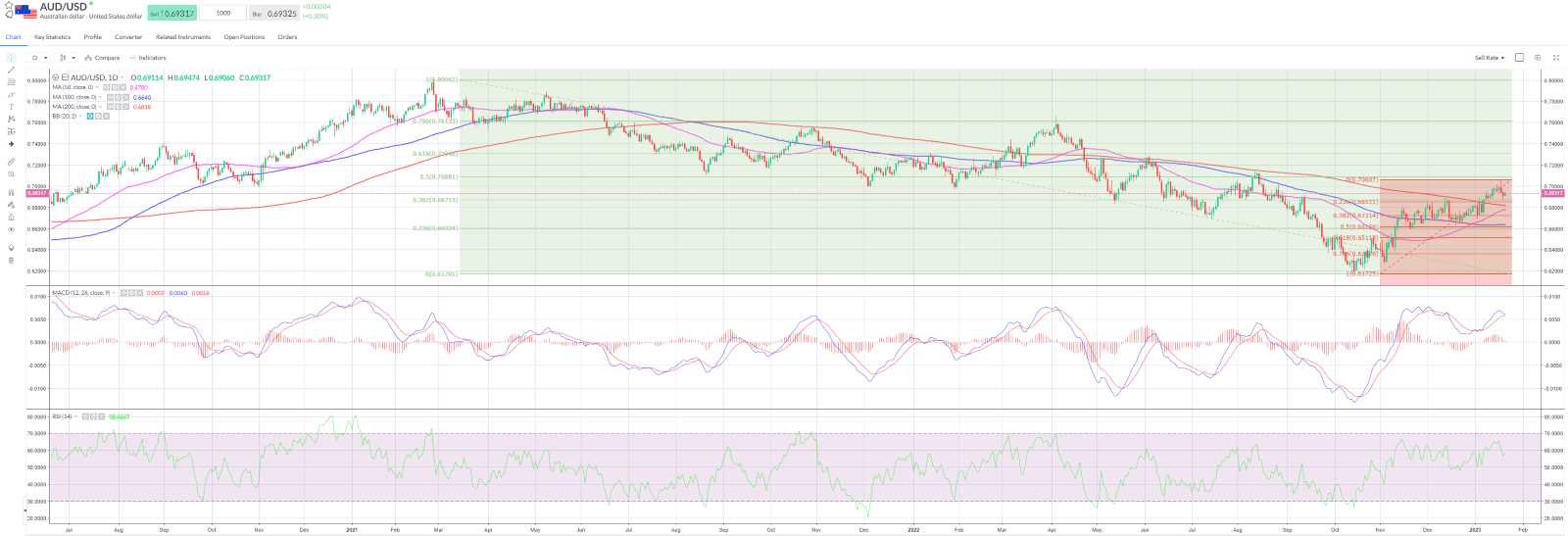
Also, on the lookout for New Zealand CPI inflation after data on Friday showed grocery inflation at a 32-year high. The RBNZ will be watching as will the Kiwi dollar, which hit its highest since June against the US dollar on Wednesday.
Tokyo inflation
And we will be on the lookout very late on Thursday for the latest core Tokyo CPI inflation print, which leapt to 4.0% from 3.6% in the prior month. National core CPI followed suit with a rise to 4%, data on Friday showed. The Tokyo figures could nudge higher still when the next set is released this week – will it do anything to nudge the BoJ to alter course?
As discussed earlier this week, there are significant risks of a fallout when the BoJ does finally abandon yield curve control. Japan does not appear to be preparing itself or broader financial markets for what most believe is an inevitable monetary policy shift in the coming months. The longer it sticks with yield curve control - in a world of rising interest rates, the worse the longer-term consequences and the harder it will be to engineer a ‘soft’ pivot. Failure to manage the exit smoothly could also have wide-ranging consequences for global financial markets.
The BoJ restated its commitment to YCC at its meeting on Jan 18th. The yen, which had rallied firmly against the dollar as traders front ran an expected exit, dropped sharply and yields pulled back from the 0.5 target ceiling. USDJPY has moved back towards 130 as of Friday morning after touching 127.2 earlier in the week. But this reprieve may prove to be short-lived. Exit from YCC will result in a significant repricing of Japanese debt and we can expect large losses in some corners, particularly among domestic holders of JGBs who have been assured of the BoJ ‘put’ for a decade. The BoJ could have chosen to go with the market wave over the last couple of weeks – it could still do so, but for now it’s holding fast to YCC.
There is a concern that a sharp repricing will result in fire sales of debt and other assets, resulting in contagion across other asset classes – Japanese equities and the yen would be among them. An interest rate shock – which abandoning YCC would cause – will expose undesirable levels of leverage on many a corporate balance sheet. It would undoubtedly send shockwaves through global interest rate markets. The effects could be worsened if it comes as US quantitative tightening really starts to put the squeeze on global liquidity. Just look at how much worry the blow up in the much smaller UK gilt market caused last year. And Japanese investors own a lot of foreign assets - about $3.2tn at the last look. If Japanese bonds start offering a decent yield, we should expect a fair amount of repatriation; i.e. selling of dollar or euro or whatever denominated assets.
USDJPY has failed to overcome downwards trendline resistance, with last week’s death cross marked.
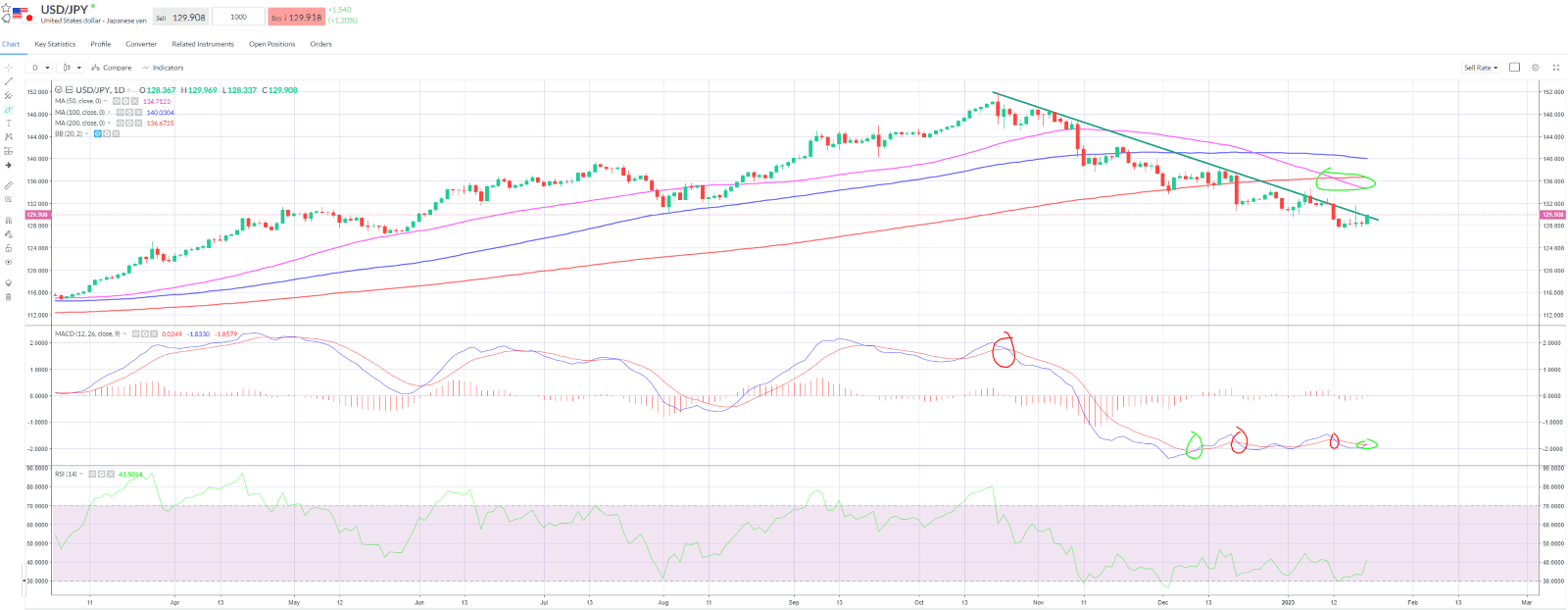
Bank of Canada
Inflation might be slowing in Canada, but it will not stop the BoC from raising interest rates on Wednesday. After hiking rates seven times to 4.25%, the central bank is likely to pursue at least another hike this week, though it may be taking its foot off the gas after inflation cooled to 6.3% in December. CPI had hit a multi-year high of 8.1% over the summer. A strong Dec jobs report means another hike to 4.5% is likely, though not a 100% done deal. Moreover, 11% grocery inflation remains a burden even as energy prices come down. Inflation is cooling but I see no reason for the BoC to stand pat and expect a hike.
USDCAD continues to consolidate lower, with the 100-day and 50-day lines hugging each other and sitting at the 23.6% retracement area – now acting as resistance having previously been support in Dec. The market bounced firmly off the 38.2% level in Nov and this is a key support. Bullish MACD crossover is in the offing, potentially suggesting near-term momentum can go with the bulls.
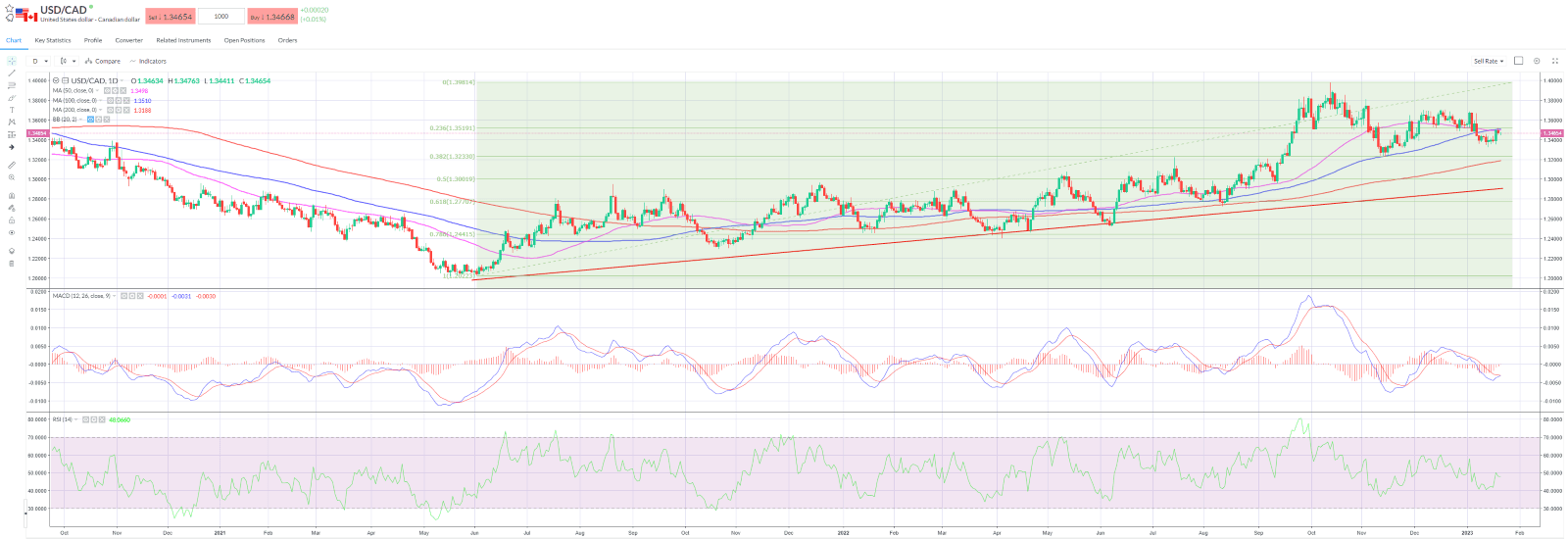
US GDP
Expectations for fourth quarter growth have moved around a fair bit, with notable weakness in retail sales and industrial production last week suggesting the US economy rather limped over the finish line in 2022. The Atlanta Fed’s GDPNow model estimate for real GDP growth (seasonally adjusted annual rate) in the fourth quarter of 2022 is 3.5%. Market estimates are for a weaker sub 2% level of growth.
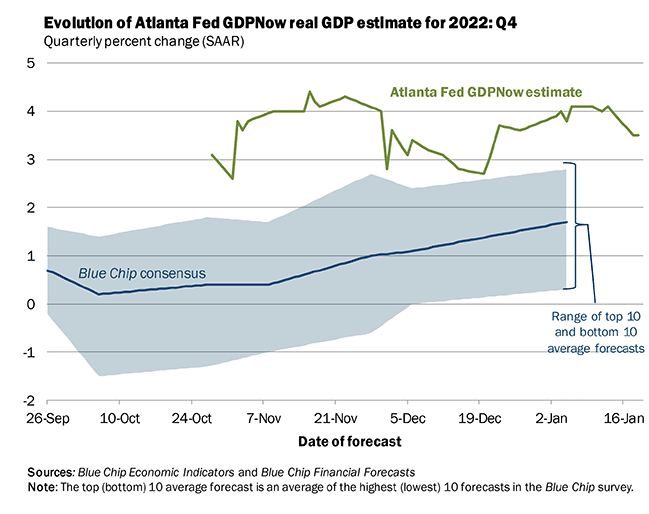
The Conference Board Leading Economic Index decreased by 1% in November 2022 to 113.5, following a decline of 0.9 percent in October. The LEI is now down 3.7 percent over the six-month period between May and November 2022— this is a much steeper rate of decline than the 0.8 percent contraction over the previous six-month period.
However, following what it called “stronger economic momentum” in the second half, the Conference Board recently revised up its Q4 growth estimate to 1.9% from 0.7%.
Although the data is, by definition, backward looking, the extent to which Q4 growth holds up will be an important lens through which to look at current forecasts for the coming quarters. It’s also important to remember from a trading perspective that we appear to have moved into a bad news is bad news period.
PCE inflation
Disinflation has been the story of 2023 thus far. This is the last piece of the inflation jigsaw for the Fed ahead of its meeting starting on Jan 31st. Four weeks ago, the Fed’s preferred gauge of inflation cooled, helping to lift market sentiment as traders pared bets on the extent of Fed rate hikes. Core PCE inflation rose 0.2% in November, up 4.7% on an annual basis, a sharp slowdown from the 5% gain in October. The headline PCE price index increased 0.1% month-on-month, up 5.5% from a year ago. This was the lowest pace of inflation since October 2021. Another slowing in the rate of inflation could be seen as a positive, but recessionary fears are mounting too. The trend is down - core PCE inflation is running at a 3.1% annualized pace on a 3-month basis—below its 3.8% reading on a 6-month basis and 4.5% on a 12-month basis. However, there are a couple of things to bear in mind. Whilst a large chunk of inflation comes from shelter – which is sensitive to rates – it may not be that higher rates leads to lower shelter costs. Rising rates force up rents, and higher rates lock more out of the housing market, forcing them to rent for longer. How this dynamic plays out in the coming months will be crucial. Second is China – whilst we don’t see much influence in the coming week’s report, the country’s end of zero covid policies may start to create upwards pressure on inflation again as the year progresses.
Tech earnings
About a quarter of the S&P 500 by market cap will release earnings next week, including Tesla and Microsoft. Tesla – price cuts don’t suggest demand is strong or the outlook all that positive.
NDX – trend friend: trend about to meet with key horizontal support at 10,600, which has been tested and held several times. Big earnings week could catalyse the breach we have been waiting for.
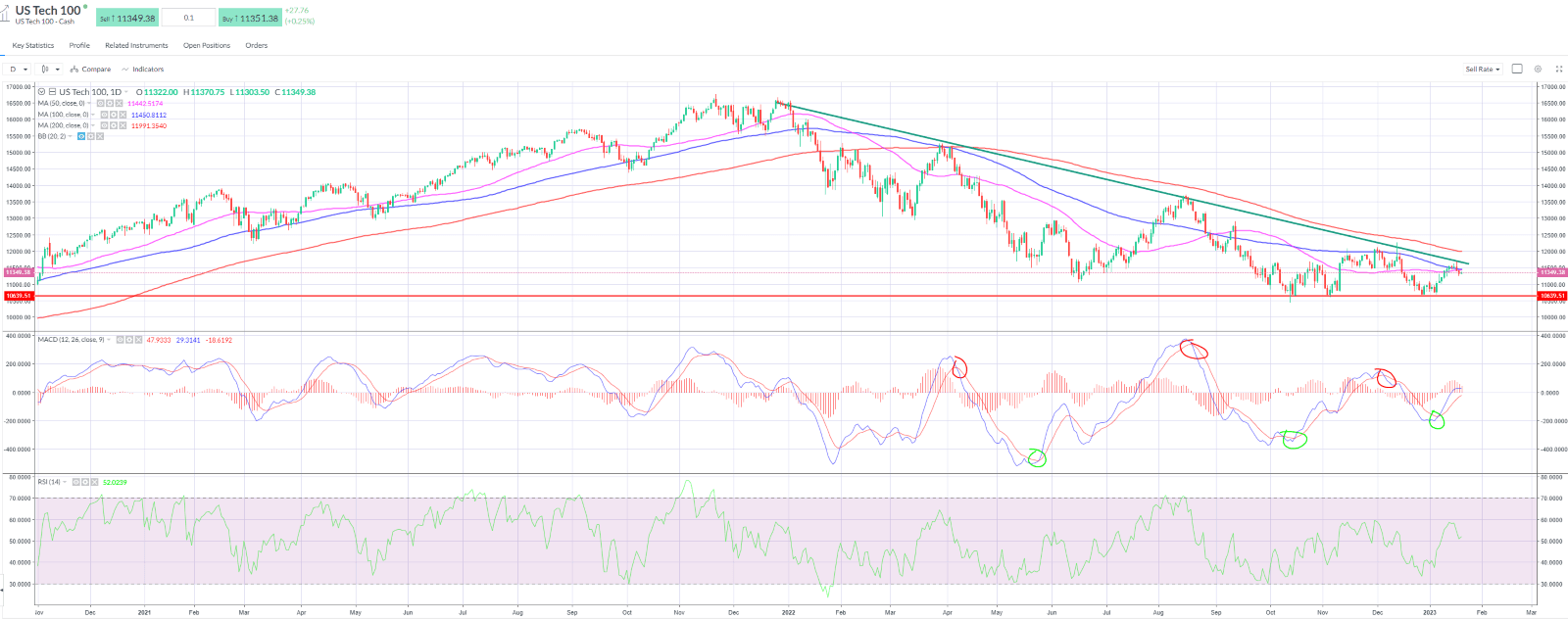
And ahead of the open on Wall St, similarly the trend remains our friend here on S&P 500 futures.
